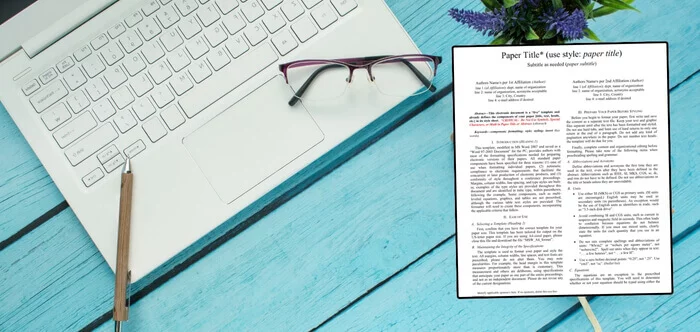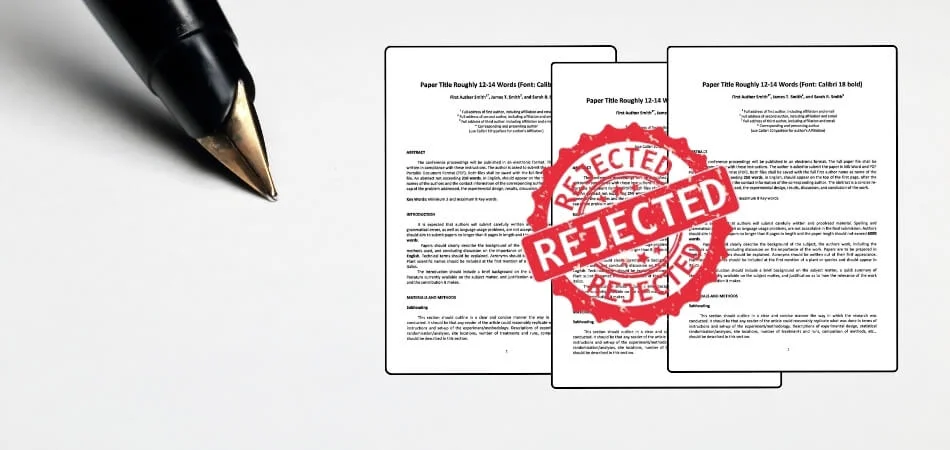Researchers and scholars seeking to share their findings and insights often submit conference papers as part of their academic journey. A pressing question in this context is, “How often are conference papers rejected?” Understanding rejection rates is crucial in setting realistic expectations.
For prestigious conferences, the rejection rate can be as high as 30-50% or more, reflecting their competitive nature. On the other hand, less selective conferences might present a more accessible platform, with rejection rates typically ranging between 10-30%.
This variability underscores the importance of knowing the landscape. In this blog, we’ll delve deeper into these statistics, explore the factors influencing rejection rates, and provide tips on enhancing your paper’s acceptance chances. Join us as we unravel the complexities of conference paper submissions.
What’s the Purpose of Conference Papers?
Conference papers serve as a pivotal platform in the academic realm, offering researchers a stage to present and discuss their latest findings. They foster intellectual exchange, contributing significantly to the progress of various fields. This sharing of ideas and research findings is essential for academic collaboration and growth.
Primarily, these papers allow scholars to showcase their work to a wider audience and enhance their visibility on platforms like Global Arts and Educational Conferences. This exposure is crucial for networking and establishing collaborative relationships with peers.
Additionally, conference papers often lead to valuable feedback, providing insights for further research and refinement. The feedback received can shape future work, honing research methods and conclusions.
Moreover, these papers are a stepping stone for publication in peer-reviewed journals, a key metric in academic success. They often act as the first draft for more extensive research articles, playing a critical role in academic publishing and career advancement.
How Often are Conference Papers Rejected?
In the competitive world of academic conferences, the journey of a conference paper from submission to acceptance is often challenging. Rejection rates, a crucial aspect to consider, can vary widely depending on the conference’s prestige and selectivity. For high-profile conferences, rejection rates can be as steep as 30-50%, while for less selective ones, they generally hover between 10-30%.
Quality of Research
The first and foremost factor influencing rejection is the quality of research presented in the paper. High-quality research, characterized by robust methodology, clear results, and significant contributions to the field, stands a better chance of acceptance. Papers lacking in these areas often face rejection due to the rigorous standards set by academic conferences.
Furthermore, the originality and relevance of the research play a pivotal role. Conferences seek innovative work that advances the field, offering new insights or solutions. Papers that reiterate known information or have marginal relevance to the conference’s theme are more likely to be rejected.
Clarity and Structure of the Paper
A well-structured paper, clear in its objectives, methodology, results, and conclusions, is more likely to be accepted. Clarity in communication is crucial; a paper that is difficult to understand or poorly organized often faces rejection. This aspect tests the author’s ability to effectively convey complex ideas.
Moreover, adherence to the specific formatting and submission guidelines of the conference is vital. Papers failing to meet these requirements can be rejected on procedural grounds. Thus, attention to detail in presentation and adherence to guidelines is as important as the content itself.
The journey of a conference paper is influenced by various factors, from the quality of research to the clarity of its presentation. Understanding these elements can greatly enhance the chances of a paper’s acceptance. While rejection rates can be daunting, they also reflect the rigorous standards maintaining the integrity of academic discourse. Aspiring contributors should view these challenges as opportunities for growth and learning in their academic pursuits.
Reasons for Conference Papers Rejection
Understanding the reasons behind the rejection of conference papers is key for researchers aiming to improve their submissions. High rejection rates in prestigious conferences indicate stringent quality standards. Recognizing these factors can guide authors in crafting more successful papers.
- Inadequate Research Quality: Papers may be rejected if the research lacks depth, originality, or significant contributions to the field. High-quality, innovative research is a fundamental criterion for acceptance.
- Poor Methodology: Flawed or unclear research methodologies often lead to rejection. Rigorous, well-explained methodologies are essential for a paper’s credibility and acceptance.
- Lack of Clarity: Papers that are poorly written, with convoluted explanations or ambiguous language, face higher rejection rates. Clarity and precision in language are crucial for effectively conveying research findings.
- Non-adherence to Guidelines: Failure to comply with the conference’s formatting and submission guidelines can result in automatic rejection. Strict adherence to these guidelines is critical for consideration.
- Irrelevance to Conference Theme: Submissions unrelated to the conference’s theme or focus area are likely to be rejected. Relevance and alignment with the conference’s objectives are key for acceptance.
In summary, the rejection of conference papers often stems from issues like inadequate research quality, flawed methodologies, lack of clarity, non-adherence to guidelines, and irrelevance to the conference theme. For aspiring contributors, understanding and addressing these factors is crucial for enhancing the likelihood of paper acceptance and contributing meaningfully to academic discourse.
What to Do When Your Conference Paper Gets Rejected?
Facing rejection of a conference paper can be disheartening, but it’s a common part of the academic journey. This experience, while challenging, offers valuable opportunities for growth and improvement. Understanding how to respond constructively to rejection is crucial for academic development and success.
Analyze Reviewer Feedback
Carefully analyze the feedback provided by the conference reviewers. This critique is often detailed, highlighting specific areas needing improvement. Reflect on this feedback objectively, identifying key issues in your paper that led to its rejection.
Use this feedback to refine and improve your paper. Addressing each point of criticism thoughtfully can significantly enhance the quality of your research. This process not only betters your current paper but also bolsters your skills for future submissions.
Seek Additional Feedback
If the conference feedback is limited, seek additional opinions from mentors or colleagues. They can provide fresh perspectives and insights that you might have overlooked. Their expertise can be invaluable in identifying weaknesses and suggesting improvements.
Incorporate this additional feedback into your revision process. Balancing the perspectives of various experts can lead to a more well-rounded and robust paper. Remember, constructive criticism is a tool for growth, not a setback.
Consider Alternative Conferences
Research other conferences where your paper might be a better fit. Each conference has its unique focus and audience, which might align differently with your research. Finding a more suitable platform can increase the likelihood of acceptance.
Submit your revised paper to these alternative conferences. Ensure that your paper aligns with their themes and submission guidelines. This approach not only broadens your academic reach but also increases your chances of success.
Improve and Resubmit
Consider resubmitting your paper to the same conference in the future. Use the interim period to significantly improve your research and address the feedback received. Improved papers that have taken reviewer feedback into account are often viewed favorably.
Stay persistent and committed to enhancing your work. Rejection is not the end but a stepping stone to further refinement and success. Embrace it as an integral part of the academic journey, leading to growth and improvement.
Dealing with the rejection of a conference paper involves a constructive response, from analyzing feedback to seeking additional opinions, considering alternative conferences, and improving for resubmission. This process, though challenging, is a vital part of academic development, turning rejection into a springboard for success and advancement in your scholarly endeavors.
Tips for Writing a Conference Paper So that It Won’t Get Rejected
Crafting a conference paper that withstands the rigorous selection process requires strategic planning and attention to detail. Navigating this process successfully is a blend of art and science, with a focus on quality and relevance. The following tips aim to guide authors in preparing a paper that stands a strong chance of acceptance.
- Understand the Conference Theme: Tailor your paper to align closely with the conference’s specific theme and objectives. Papers that resonate with the conference theme are more likely to be accepted.
- Ensure Research Originality: Emphasize the originality and significance of your research. Unique contributions that offer new insights are highly valued in conference submissions.
- Adopt a Robust Methodology: Employ a clear, well-structured, and justified methodology in your research. A strong methodology enhances the credibility and reliability of your findings.
- Write Clearly and Concisely: Prioritize clarity and brevity in your writing. Papers that are easy to understand and succinctly presented are more favorably received.
- Follow Submission Guidelines: Adhere strictly to the conference’s formatting and submission guidelines. Non-compliance with these guidelines can lead to automatic rejection.
- Seek Feedback Before Submission: Obtain feedback from peers or mentors before submission. This pre-review can identify potential weaknesses and improve the paper’s quality.
In summary, writing a successful conference paper involves understanding the conference theme, ensuring research originality, adopting a robust methodology, writing clearly, following submission guidelines, and seeking feedback before submission. These steps, when carefully executed, significantly increase the chances of acceptance, marking a positive step in your academic journey.
Bottom Lines
Concluding our exploration into the academic world of conference papers, it’s evident that understanding the question “How often are conference papers rejected?” is fundamental for researchers. While varying significantly across conferences, the rejection rates underline the importance of meticulously preparing and submitting papers.
Key strategies for success include aligning with the conference theme, ensuring research originality, adopting a robust methodology, and writing clearly. Furthermore, adherence to submission guidelines and seeking pre-submission feedback are crucial steps in avoiding rejection.
These practices not only enhance the chances of acceptance but also contribute to the overall quality and impact of the research. In the event of rejection, constructive engagement with feedback, seeking alternative conferences, and resubmission efforts underscore resilience and dedication to academic excellence. This comprehensive approach, balancing meticulous preparation with a willingness to learn and adapt, is vital in navigating the challenges and uncertainties inherent in academic submissions.








